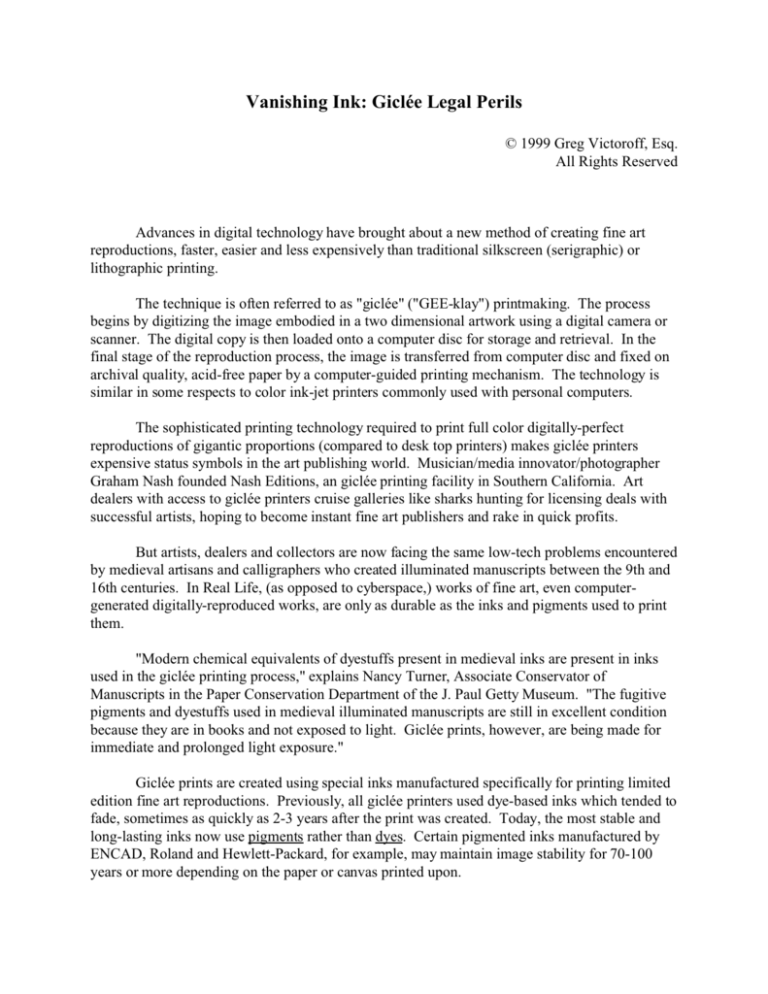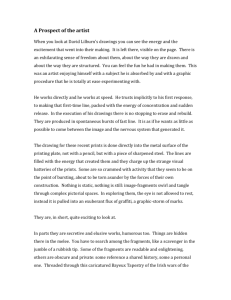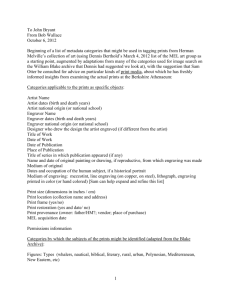
Vanishing Ink: Giclée Legal Perils
© 1999 Greg Victoroff, Esq.
All Rights Reserved
Advances in digital technology have brought about a new method of creating fine art
reproductions, faster, easier and less expensively than traditional silkscreen (serigraphic) or
lithographic printing.
The technique is often referred to as "giclée" ("GEE-klay") printmaking. The process
begins by digitizing the image embodied in a two dimensional artwork using a digital camera or
scanner. The digital copy is then loaded onto a computer disc for storage and retrieval. In the
final stage of the reproduction process, the image is transferred from computer disc and fixed on
archival quality, acid-free paper by a computer-guided printing mechanism. The technology is
similar in some respects to color ink-jet printers commonly used with personal computers.
The sophisticated printing technology required to print full color digitally-perfect
reproductions of gigantic proportions (compared to desk top printers) makes giclée printers
expensive status symbols in the art publishing world. Musician/media innovator/photographer
Graham Nash founded Nash Editions, an giclée printing facility in Southern California. Art
dealers with access to giclée printers cruise galleries like sharks hunting for licensing deals with
successful artists, hoping to become instant fine art publishers and rake in quick profits.
But artists, dealers and collectors are now facing the same low-tech problems encountered
by medieval artisans and calligraphers who created illuminated manuscripts between the 9th and
16th centuries. In Real Life, (as opposed to cyberspace,) works of fine art, even computergenerated digitally-reproduced works, are only as durable as the inks and pigments used to print
them.
"Modern chemical equivalents of dyestuffs present in medieval inks are present in inks
used in the giclée printing process," explains Nancy Turner, Associate Conservator of
Manuscripts in the Paper Conservation Department of the J. Paul Getty Museum. "The fugitive
pigments and dyestuffs used in medieval illuminated manuscripts are still in excellent condition
because they are in books and not exposed to light. Giclée prints, however, are being made for
immediate and prolonged light exposure."
Giclée prints are created using special inks manufactured specifically for printing limited
edition fine art reproductions. Previously, all giclée printers used dye-based inks which tended to
fade, sometimes as quickly as 2-3 years after the print was created. Today, the most stable and
long-lasting inks now use pigments rather than dyes. Certain pigmented inks manufactured by
ENCAD, Roland and Hewlett-Packard, for example, may maintain image stability for 70-100
years or more depending on the paper or canvas printed upon.
During the fall of 1996, however, IRIS Graphics, Inc. of Bedford, Massachusetts, one of
the leading manufacturers of digital printers and inks, began selling ink sets for giclée printing.
Ironically, IRIS chose the name "Longevity" for the new inks. Unfortunately, testing of the
Longevity inks essentially showed that Longevity inks lacked longevity. In the manufacturer's
words, the inks did "not perform at a level consistent with IRIS Graphics' high standards."
Knowledgeable artists have suggested that one or more colors of the Longevity inks
change or fade or both over a period of 4-5 years or less.
On March 10, 1997, several months after Longevity inks (and giclée prints created with
them) were first sold, IRIS Graphics, Inc. sent written notification to their customers of the poor
performance of the inks and announced that IRIS was discontinuing manufacturing them in their
present form. IRIS offered refunds for any unused inks and stated that further supplies of
Longevity inks would only be provided if the customer executed a written waiver of liability.
The announcement caused justifiable concern for artists and print buyers whose limited
edition IRIS giclée prints may degrade and lose value over the next 4-5 years and because of the
negative effect the ink problem may have on the overall market for the new-fangled multiples.
Similarly, dealers, artists and other sellers of IRIS giclée pieces printed with defective inks who
fail to disclose or don't give an express disclaimer that the images may not remain intact for more
than a few years, may be liable to unsuspecting buyers under several legal theories.
Ruth Morrow, a Los Gatos, California artist whose IRIS giclée limited edition was
printed using Longevity inks after the March 10, 1997 recall, acknowledging her duty to disclose
the latent defects in the prints to potential buyers, commented: "If you thought selling a piece of
art was hard before, just imagine trying to sell one of these clunkers."
Legal problems involved in selling giclée prints created with Longevity inks or other inks
which are known not to perform up to industry standards, boil down to two issues:
1)
Whether a printer's use and sale to consumers (knowingly or innocently) of inks
which were discontinued by the manufacturer for substandard performance, in connection with
printing giclée limited edition prints without disclosing or disclaiming the ink's substandard
performance, constitutes a breach of the printer's legal duties or the rights of the artists,
customers, dealers or collectors purchasing such substandard prints?
2)
Whether an artist's (or dealer's or other seller's) sale of giclée prints (or other
multiples) which were (knowingly or innocently) created using inks which were discontinued by
the manufacturer for substandard performance, without the artist disclosing or disclaiming the
inks' substandard performance, constitutes a breach of any legal duty owed by the artist, dealer or
seller to a collector/purchaser of such prints?
In both cases under California law and the Uniform Commercial Code (U.C.C.) (A body
of laws applicable to transactions between merchants in nearly all 50 states,) the answer is yes.
Printer-Customer Transactions
Under U.C.C. section 2314(1), a warranty of "merchantability" is implied in any sale
by a "merchant", (such as a printer) of goods of the kind normally sold, unless expressly
disclaimed. "Merchantability" means the goods are free from defects which would not permit
them to pass without objection in the trade and are fit for ordinary purposes for which the goods
are sold.
Further, under U.C.C. section 2315, if the seller (printer) knows that the buyer (artist or
dealer) desires goods (ink and prints) to be used for a particular purpose (collectable limited
editions) and the artist/dealer relies on the printer's skill and judgment in selecting or furnishing
such inks and prints, a further warranty is implied by law, unless excluded, that the goods will be
"fit" for the purpose for which they were sold. And the warranty of fitness for a particular
purpose is not limited to sales by a merchant, like the warranty of merchantability. The fitness
warranty is imposed on any seller possessing sufficient skill and judgment to justify the buyer's
reliance.
Additional implied warranties created by the "course of dealing or usage of trade" are
recognized under U.C.C. section 2314(3).
Moral Rights Violations
California's "droit moral" statute (Civil Code section 987) predates federal moral rights
legislation by more than a decade. Unlike the federal statute however, the definition of "fine art"
covered by the California statute refers to an "original painting, sculpture or drawing..." and does
not expressly include multiples such as giclée limited edition prints.
In contrast, the federal Visual Artists Rights Act of 1990 ("VARA") (17 U.S.C. § 106A et
seq.) protects specified works of visual art (including prints in a limited edition of 200 or fewer)
from intentional destruction, mutilation or modification harmful to the artist's reputation or
honor. But even if a printer's conduct in creating substandard prints is not merely negligent, but
is intentional, grossly negligent or reckless, legal recourse against the printer for violating the
"droit moral" or moral rights of the artist under VARA is not certain. Destruction of a work by
passage of time due to the inherent nature of the materials used is expressly excluded from the
protection of the law, 17 U.S.C. § 106A(c)(1). A persuasive argument can be made, however,
that this exception was not intended to apply where the artist didn't choose the materials and the
defective materials caused a modification harmful to the artist's reputation.
Unauthorized Copying
A related concern of artists involves the electronic security of digital copies of images
embodied in the giclée prints, stored on photographers' and printers' discs and computer hard
drives. On the Internet, digitally-stored copies of art regularly appear in websites, advertisements
and "virtual art galleries." Unlicensed digital archiving and Internet postings provide an easy
means for unauthorized reproductions to be made. Variously characterized as unauthorized
"transmission", "distribution", "reproduction", "display" or "performance" of the art,
unauthorized Internet postings constitute an infringement of the artist's copyright.
Notwithstanding that 17 U.S.C. section 117 permits owners of authorized copies of software to
copy the software into the memory of a computer and make a single archival copy, using digital
copies of artworks to reproduce giclée prints or other copies, hard or soft, violates federal
copyright law. Moreover, California Civil Code section 982, which reserves to artists
reproduction rights in works of fine art, to the extent it is not preempted by federal copyright law,
could also be violated by electronic copying and transmissions. Unlike Civil Code section 987,
(California's moral rights statute), the definition of "fine art" covered under Civil Code section
982 expressly includes lithographs, offset and silk screen prints and other multiples.
Artist/Dealer - Collector Transactions
In California, under the Consumer Warranty Act (Civil Code section 1790 et seq.) selling
any new product for use primarily for personal, family or household purposes carries the same
implied warranties of merchantability and fitness present in sales between merchants. That
means that an artist selling to a collector owes many of the same legal warranties which the
printer owes to the artist. And the fact that the printer may have breached its warranties will
generally not be a defense to a lawsuit against the artist by an angry collector.
Fine Print Disclosure Laws
California's fine print disclosure law, (Civil Code section 1742 et seq.), is one of the most
stringent laws in the U.S. regulating the sale of fine art multiples. A similar fine print disclosure
law exists in New York. Other laws relating to fine print sales are on the books in Michigan,
Arkansas, Hawaii, Illinois, Maryland, Minnesota and Oregon. Remarkably, these laws offer little
or no protection to buyers of IRIS giclée prints created with defective inks.
Art dealers in California have a statutory duty to provide buyers of fine art multiples with
a detailed Certificate of Authenticity specifying over a dozen facts about each work sold. If no
Certificate is provided or if the Certificate contains information which is mistaken or untrue, art
dealers must accept the return of the piece and refund to the buyer the full price paid. If the
Certificate is willfully not provided or intentionally false, dealers are liable to the buyer for three
(3) times the price paid.
But because the law's purpose is to chronicle the provenance and authenticity of fine art
multiples rather than to ensure the quality of the materials used to create them, none of the
informational detail required for Certificates of Authenticity expressly calls for disclosing
substandard inks. An unscrupulous artist or dealer could provide a complete and truthful
Certificate of Authenticity under California fine print disclosure law without disclosing that the
inks will substantially fade or change over a relatively short period of time. Because fine print
disclosure laws in most states were drafted before the advent of digital printmaking, statutes do
not expressly require disclosure of: 1) the type of printer used; 2) the type of ink used; 3) the
longevity of the image under normal display conditions before noticeable fading occurs; 4) the
characteristics of coatings used over inks; 5) the type of canvas, paper or other material printed
upon and its effect on the image's longevity; 6) the extent of retouching or over-brushing; 7) the
size of the edition; 8) the location(s) and owner(s) of digital “masters”, (i.e., disks or hard drives
from which new prints may be created); and 9) any standardized method for authenticating and
limiting specific editions and prints. The International Association of Fine Art Digital
Printmakers is a newly-formed trade organization striving to find a consensus for standards and
practices in the digital printmaking industry. But notwithstanding the current absence of such
digital standards printmaking and loopholes in federal and state moral rights and fine print
disclosure laws, unless expressly disclaimed (orally or in writing), the implied warranties of
merchantability and fitness nevertheless impose liability on sellers of artworks created with
defective inks.
Perhaps the simplest advice to sellers of defective goods, including ephemeral artworks,
is to use the all-purpose disclaimer: "as is" in connection with all sales.
Greg Victoroff, Esq. practices entertainment and copyright law and litigation with an
emphasis on art law. He is Editor and co-author of The Visual Artists Business and Legal Guide.
(Prentice Hall, 1995). He gratefully acknowledges the assistance of Ruth Morrow, Nancy
Turner, Barb Dougherty and Art Calendar Magazine in preparing this article.
\\Poweredge\victoroff\Articles\Giclee3




